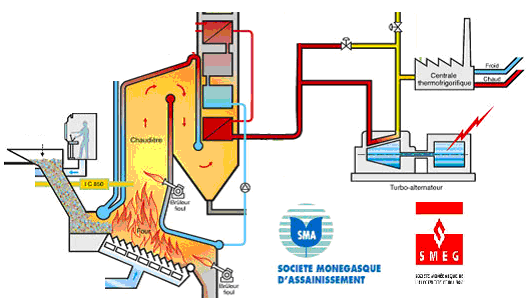UIRUI (SMA) and CCFU (SMEG) :
This waste treatment plant is the 3rd generation of incinerator in the Principality. Opened in the 80s, the plant has allowed the Principality to become a pioneer in waste-to-energy solutions. This sector presents many advantages, in particular the significant reduction in volume (by approximately 90%) and mass (by 75%) of waste (waste mineralisation). The SMA (Société Monégasque d’Assainissement) has been continuously developing its equipment, thereby contributing to the major economic and ecological challenge of protecting the environment. Boasting cutting-edge operating equipment, it complies with the strictest European standards pertaining to the treatment of gases, liquids and solids produced during the combustion process. Its footprint of only 1,500 m2 explains its vertical design, which houses 3 furnaces / boilers (two are able to operate simultaneously) and two flue gas treatment lines, capable of incinerating 78,000 tonnes of waste per year.
Thanks to this waste, the plant generates high pressure steam, which by passing through the turbine generator, produces electricity to supply the facility; any surplus electricity produced is fed into the Monegasque grid. Furthermore, the low-pressure steam from the turbine generator is directed to the neighbouring cooling and heating plant which converts it into chilled and hot water. These fluids are distributed to buildings and industrial facilities in the Fontvieille district by SMEG (Société Monégasque de l’Electricité et du Gaz).

Simplified diagram of the UIRUI tri generation principle
The Grimaldi Forum:
This building, completed in 2000 and covering a surface area of 75,000 m2, manages its energy consumption in the most efficient way possible. Adopting an environmental approach for its design, and subsequently obtaining ISO 14 001 certification, Monaco’s cultural and convention centre has successfully exploited the benefits of its maritime situation. It has natural thermal insulation (2/3 of the building is below ground and it uses HQE recyclable materials), energy-saving lights and a renewable source of energy: the seawater.
The hot and chilled water necessary for the building’s air handling system and consumption is produced by a set of 4 screw heat pumps connected to a seawater tank. Pumped offshore, the seawater transfers or absorbs, depending on the needs or season, the calories and frigories necessary to control the temperature and humidity of the premises. Boasting high performance with a thermal impact on the sea that is virtually nil, this process actively promotes energy savings by using the seawater, a renewable energy, as a raw material. This also avoids the need to build cooling towers and their related nuisances.
To ensure optimal energy regulation in the building, the set-up also features a centralised technical management system enabling the various components (lighting, air conditioning/heating…) to be accurately monitored and controlled.

Visit to the solar power system in the « Jardins d’Apolinne » building:
This very recent building (delivered in 2012), belonging to the Public Lands Administration (Department of the Government of Monaco), is one of the new infrastructures built on the former railway line connecting Nice to Menton. Its implementation in the restricted urban environment of the Principality was to be exemplary and therefore was carried out in accordance with the HQE approach (High Environmental Quality). Upon completion of the work, the building was awarded the THPE label (Very High Energy Performance). Consequently, among the evaluation criteria or « targets » of the HQE approach, « Management of Energy » was classified as extremely efficient. « Les Jardins d’Apolline » are equipped with a roof solar system consisting of both solar heating and photovoltaic panels with an energy power equivalent to 335,000 kWh/year.
|
Les Jardins d’Apolline |
Surface of the panels in m2 |
Production in kWh/year |
| Solar heating: | 380 | 300 000 |
| Solar photovoltaic: | 200 | 35 000 |
Tests concerning Electric Vehicles:
The policy conducted by the Monegasque State with regard to mobility is aimed at reducing the negative impacts of motor vehicles (traffic, air quality, noise pollution, etc.), but also to offer alternative modes of travel. Some of these alternative modes include the development of public transport, the development of soft modes of transport and the promotion of clean or low-emission vehicles.
Thus, the Monaco Bus Company is experimenting self-service electrically-assisted bicycles whilst the Public Car Parks Department manages forty or so electrically-assisted bikes which are freely accessible to residents of the Principality. This Department has also installed 400 charging points in various locations, available without cost to all users of electric vehicles. The State and the Municipality of Monaco are setting an example, as almost all vehicles purchased by these administrations are today electric or hybrid. In addition, financial aid is allocated to those buying an electric or hybrid vehicle. Currently the Principality has over 550 electric or hybrid vehicles, i.e. 1.6% of the vehicle fleet registered in the Principality.
Most of the vehicles provided for these tests will come from various Departments of the Monegasque Administration, and are the result of partnerships with private manufacturers: Mitsubishi, Smart, Venturi, etc. which assess innovations and the technical capacity of their vehicles on a regular basis.
